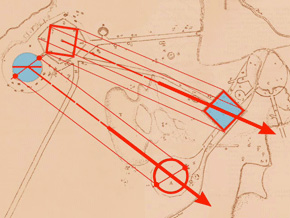GEOMETRICAL PRECISION
NEWARK
NEWARK
GEOMETRICAL PRECISION
Ellipses, squares, octagons, circles, parallel walls: The builders of ancient, monumental Newark clearly knew how to lay
out huge geometric shapes with great precision. These different figures used common dimensions. The diameter of the
Observatory Circle forms a square inscribed in the Octagon. Laid out six times, it marks the distance to the Great Circle,
or that from the Octagon to the Square.
Parallel lines would connect the corners of the square with those of the Octagon, more than a mile away. Another set would
connect the main axis points of the two large circles. Incredibly, these two sets of imaginary parallels mark the minimum
and maximum southern moonrises. There are also matched circumferences, and areas. These startling relationships show that
somehow, there’s a larger, unifying idea – it’s not just a haphazard or incremental arrangement.
The High Bank earthwork near Chillicothe is the only other Circle-Octagon; its central axis is at 90 degrees from Newark’s.

The design of the overall Newark complex was not haphazard, but contained precise mathematical relationships and alignments.